|

















| |
The JB-2 Loon Missile
It was born at Pt. Mugu, just
off the coast of California and a few years after World War II. It became the future
of
Hitler's terror weapon called the V-1 Buzz Bomb that had wreaked havoc,
terror and death on England for so many months. Its capture and the subsequent
re-build and experiments by the US Navy laid the foundation for what would
become the most lethal and devastating weapons systems known to man. It
would be the ultimate stealth weapon, carried silently beneath the seas in ballistic and
cruise missile carrying submarines.
|
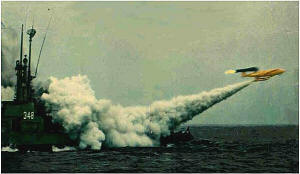
Cusk's First Launch
The first Loon launch by the Cusk on February 12, 1947 near Pt. Mugu, California |
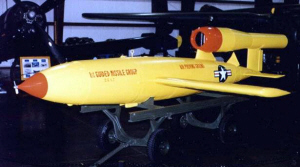
Loon Missile in the Air
& Space Museum
|
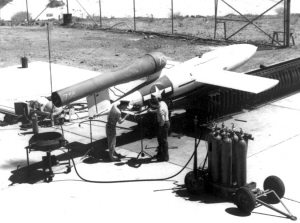
Loon Missile being tested at Pt. Mugu
(Photo courtesy
of Tom Roseland ) |
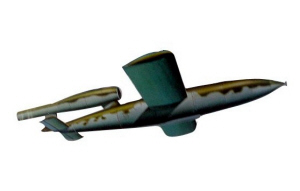
Artist conception of a Loon Missile
Circa 1947
(Photo courtesy
of Tom Roseland) |
|
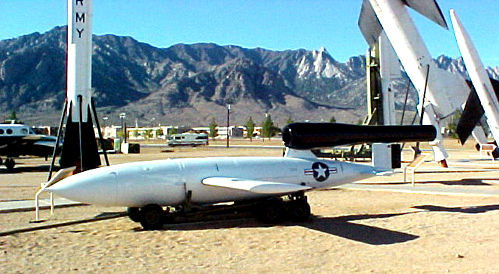
JB-2 Loon
White Sands Missile Range photo |
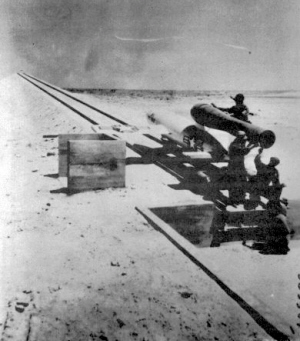
Test launch at Pt. Mugu, California
(Photo courtesy of unknown) |
The Loon was the U.S. Navy's copy of the German V-1. The U.S. Army Air Forces'
copy was designated JB-2. Intended for launching from ships against ground
targets, the Loon had a pulse jet engine, a range of 150 miles, and was tracked
by radar and controlled by radio. All Loons built were used in tests after
the war. None were fired in combat.
This missile was developed by the Army Air Forces (AAF)
beginning in 1944. As with the V-1, the AAF intended the JB-2 to be a
ground-launched missile used against ground targets. The AAF started flight
tests in October 1944. The Navy developed interest in the AAF program shortly
thereafter, intending to launch the missile from escort carriers with guidance
from either shipboard or airborne radar.
Formally, the Navy's project was initiated under the
Bureau of Aeronautics in April 1945 and at that time the missile was designated
the Loon. (Initially, the Navy also designated the Loon as KGW-1 then in
1946 redesignated it as KUW-1.) The Bureau of Aeronautics received some
JB-2s from the AAF, and in June 1945 contracted with Republic Aviation for 151
missiles. The XM-1 system (using a slotted tube powder catapult) was
selected for the launching system.
The Loon was 27 feet long and had a wing span of 18
feet. It carried a 2,100 pound warhead and weighed 5,020 pounds with the
warhead and fully fuelled. Powered by a PJ 31-1 pulse jet which developed
a gross thrust of 850 to 900 pounds at a specific impulse of about 1,100 pounds
per second, the Loon had a 180 gallon tank and could use any gasoline-type fuel.
Control surfaces on the airframe consisted of a rudder and elevators. The Loon
was tracked by radar to the target and was controlled by radio.
Stabilization was provided by 3 air-driven position and rate gyros. An
aneroid unit and magnetic compass controlled altitude and course through the
gyro system.
In late 1945, tests of the XM-1 system using dummy
Loons were conducted at Point Mugu Naval Base in California. Several
operational tests of the missile took place at this base in early 1946.
Directives were then issued in March 1946 to develop a launching capability from
submarines. Submarine launchings started in February 1947 from the U.S.S.
Cusk (SS-348). Several months later, the U.S.S. Carbonero (SS-337) joined
the tests and acted as the control and tracking station. Based on the
successful results of these tests, the Navy directed in August 1947 that
submarine launchings continue through 1949 to develop terminal guidance
procedures and tactical concepts for the Regulus, a submarine-launched guided
missile with a range of 500 miles that was then under development.
In late 1948, directives were issued to develop a
launching capability from surface vessels as well. The U.S.S. Norton Sound
(AV-11) was selected as the platform, and four successful launchings from her
took place in 1949 and 1950. The Loon project was cancelled after the last
of these.
With a maximum range of 150 miles, the Loon was
launched at a minimum speed of 220 m.p.h. It climbed at a rate of 500 to
1,000 feet per minute to the altitude set on its altimeter. The optimum
altitude in flight was between 2,000 and 4,000 feet, and the optimum speed in
flight 400 m.p.h.
The Loon was one of the first guided missiles built by
the U.S. Navy. Knowledge gained from its testing onboard submarines and
surface ships led to the subsequent development of more advanced guided
missiles, and eventually the sea launched cruise missiles which are still
deployed by the fleet today. |
